Archive Episodes
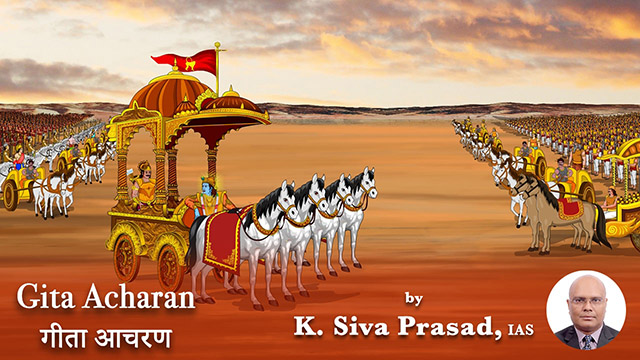
132. Misery Loves Company
Krishna described his higher nature (para-prakruti) which is the life-element beyond the three gunas.

131. Transcending Illusions
Krishna mentioned about three gunas (characteristics) which are born of prakriti (nature) and all of us are made to perform different karmas (actions) in different ways by them (3.5).
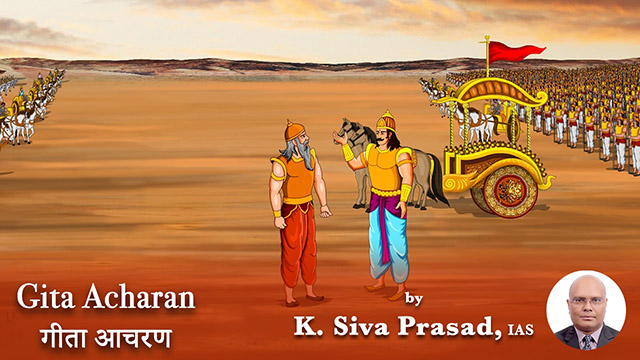
130. Knowing the Unknowable
Krishna described his param prakriti (higher nature) as the 'life element' which supports the universe (7.5) and gives the example of the string which supports the gems to form a beautiful ornament (7.7).

129. God Plays Dice
At the time of the creation of the universe, it was pure energy and matter formed subsequently.

128. Every End is a Beginning
Krishna says, "I shall explain to you Jnana (knowledge) and Vijnana (wisdom). When you realise them, nothing more here remains to be known" (7.2).

127. Learn to Listen, to Learn
A two dimensional map is used to represent a three dimensional territory. It's an easy, useful and convenient way, but has its limitations. We need to experience the territory to fully appreciate it.

126. Supremacy of the Yogi
Krishna says, "The yogi is superior to the tapasvi (ascetic), superior to the jnani (a person of learning), and even superior to the karmi (ritualistic performer). Therefore, O Arjun, strive to be a yogi (6.46).

125. Genesis of Fortune
Arjun enquires if one has to start all over again (6.38) while practising (vairaagya) with shraddha (trust), but dies on the path before he attains this (6.37).

124. No Shortcut to Hard Work
Krishna talked about establishing in oneness whatever may be the mode of living (6.30) to attain infinite bliss. There are three major issues faced by us to attain oneness.

123. Beyond the Comfort Zone
A couple of centuries ago no one in Europe knew about the existence of the Americas. When Columbus reached there, it was beyond his comprehension that there is a massive continent waiting to be discovered, as his knowledge was limited to the geography of the day. He mistook it to be Asia and the rest is history.

122. It Is Him
Coming as paramatma , Krishna says that for he who perceives me everywhere and sees all in me, I am never lost, nor is he ever lost to me (6.30). This verse is the foundation for Bhakti Yoga where practitioners perceive paramatma everywhere and in every situation.

Power of Namaste
' Namaste ' or ' Namaskaaram ' is used to greet each other in the Indian context. Its meaning is 'obeisance to divinity in you'. Greetings used in various cultures convey a similar message and have origins in "Seeing the self in all beings and all beings in the self and see the same everywhere" (6.29).

120. Self in All: All in Self
Existence is the coherence of the manifested like our body and the un-manifested or atma (self). We perceive existence either through the manifested or through the un-manifested.

119. Coherence of Awareness and Compassion
Samatva or equanimity is the crux of the preachings of every enlightened soul that has ever roamed this planet. Words, languages and methods could vary but the message is to attain samatva. Any preaching or practice contrary to this is dogmatic.

118. Change is the Only Constant
Change is constant in the physical or manifested world of objects and the unmanifested or atma remains changeless.

117. The Art of Restraint
The Brain is an amazing organ for many reasons. One of its attributes is that it doesn't feel pain as its tissue doesn't have pain transmitting nociceptors.

116. Spirituality Simplified
The common observation one makes about the spiritual path is that it is difficult to follow. Krishna earlier assured such people (2.40) that small efforts bring big gains in Karma Yoga.

115. A Method of Meditation
Krishna says you are either your own best friend or your own worst enemy (6.6).

114. Avoiding Extremes (8-5-22)
Krishna spoke about treating gold, stone and a handful of soil as equal (6.8), further he said that he who has equal regard for the patrons, strangers, relatives, friends, enemies, meditators, hateful beings, righteous and ungodly, is the best (6.9).

113. Accepting Situations As They Are (1-5-2022)
Krishna says, "The Yogi, who is satisfied with jnana and vijnana (jnana-vijnana-triptha-atma), who remains unshaken, who has conquered the senses, to whom a lump of earth, stone and gold are the same, is said to be realised one" (6.8).

112. Beware of Enemy Within (24-04-2022)
After declaring that one is responsible for lifting up or degrading oneself (6.5), Krishna gives a path to discharge this responsibility when he says, "For him who has conquered his self, the self is his bandu (friend/relative) but for him who has not conquered his self, the self verily hostile like the enemy" (6.6).

111. Befriending Self (17-04-2022)
Krishna says, "Let man lift himself by himself, let him not lower himself; his self alone is his bandhu (friend/relative), his self alone is his enemy"(6.5). Like friendship, there are many dimensions to this existential verse.

110. Tranquility of transcending polarities (10-04-2022)
Krishna says, "Know yoga to be that which scriptures call sanyasa (renunciation); nobody becomes a yogi without renouncing sankalp (motive/will)" (6.2).

109. A Sanyasi renounces karma-phal (03-04-2022)
Life presents many ups and downs and it's all about how we handle them. It is natural that when one is going through a rough phase.

108. Transcending Anger (27-03-22)
Krishna says, "For those who are free of desire and anger, mind controlled, and self realised, are completely liberated both in this world and in the beyond" (5.26). The question is how to be free from the malady of desire and madness of anger.

107. Meditation for Bliss (20-3-22)
The pineal gland is a pea sized, pine cone shaped organ situated at the center of the brain, directly behind the middle of two eyebrows.

106. Reins of Happiness. (13-3-22)
Once, an invader on horseback from Central Asia had occupied Delhi and wanted to have a victory procession. An elephant was decorated and upon mounting it, he asked for the reins of the elephant.

105. Eternal Happiness (06-03-2022)
Krishna says that those established in brahman (absolute), having a firm understanding of divine knowledge and not hampered by delusion, neither rejoice in getting something pleasant nor grieve on experiencing the unpleasant (5.20).

104. Attaining Impartiality (27-02-2022)
Krishna says that whose mind and intellect are established in 'that' (spirit) and whose sins have been dispelled by awareness reach a state of no return (5.17).
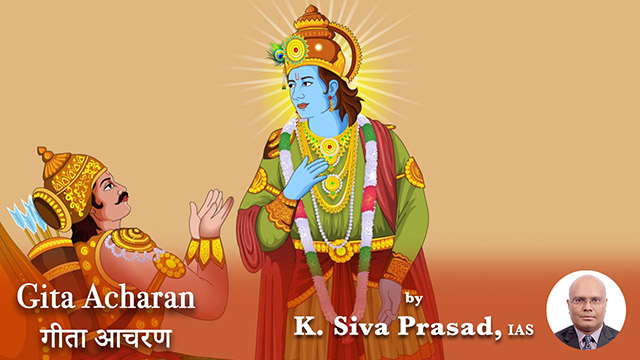
103. Roots of Virtue and Sin (20-02-2022)
Krishna says that the Prabhu (Lord) creates neither doership nor actions nor union with fruits of action for the world. The delusive cosmic nature is the originator of all these (5.14).

100. Being Proactive
Life is a two way process. We receive various stimuli and we keep responding to them.

99. Renounce Hatred Not Karma
Out of ignorance, one tends to grab material possessions thereby leading to the bondage of action to accumulate.

97. Sword of Wisdom
Krishna says, "He who has relinquished work by yoga and has torn apart his doubts by wisdom, becomes poised in the self; actions don't bind him (4.41).
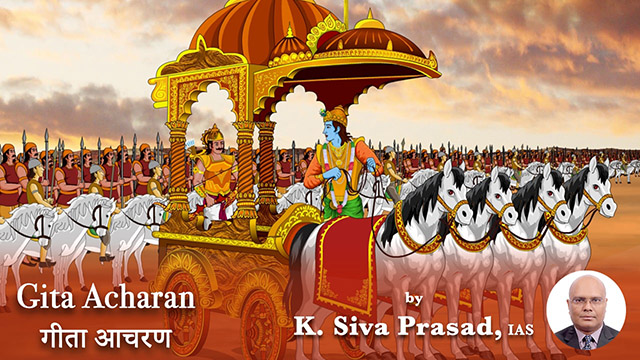
96. Wisdom is In the Self
Krishna says, "He who has relinquished work by yoga and has torn apart his doubts by wisdom, becomes poised in the self; actions don't bind him (4.41).
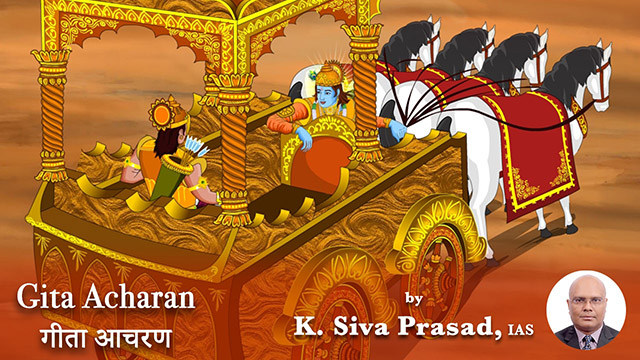
95. Raft of Wisdom for Sea of Sin
Arjun's despondency during the Kurukshetra war is due to his feeling that he is committing a sin. He feels that killing one’s teachers, relatives and friends (1.36) is nothing but sin and that we should turn away from such sinful action (1.38).

94. Art of Learning
The ability to learn throughout life is a human endowment. The fundamental question is how to learn and what to learn. Krishna says, "Know 'that' by prostration, questioning and service, the wise who have realised the Truth will teach you the knowledge." (3.34)

93. Nectar of contentment
Krishna talked about yagna (selfless actions) at two places (3.9 to 3.15 and 4.23 to 4.32). He cautions (3.9) that motivated actions bind us (karma-bandhan) and advises action to be performed without attachment.

92. Joy through Breath
Some activities in the human body like the beating of the heart are automatic though they may follow a set rhythm while some activities like the limbic system can be controlled.

91. Study of Self
Having ‘Fire in the belly' means being full of energy and enthusiasm for pursuing one's desires, interests and duties in the physical world.

90. Sacrificing Sacrifice
Yagna symbolises sacrifice or selfless actions. In this context, Krishna says (4.25), "Some yogis perform sacrifices to gods; others perform sacrifice by offering sacrifice itself in the fire of Brahman (Supreme God)."

97. Sword of Wisdom
In the Gita, some words like anaasakti and veet-raag represent the crux of the Gita. While aasakthi (attachment) and virakti (detachment) are two polarities, anaasakti transcends these polarities.

Facets of Sin
The question of vikarma (prohibited action) or sin is very intriguing. Arjun is also in this very dilemma and says that sin alone will accrue by killing relations in battle (1.36).

Ever Content
A hungry fox tried to reach for grapes hanging high above, failed and moved on bringing itself to think that the grapes were sour.

Drop both Lust and Resolve
Every culture evolved some dos and don'ts for peace in society and with the evolution of justice systems, some don’ts have become punishable crimes.

Karma, Akarma and Vikarma
‘Acts of commission and omission' is a phrase commonly used in the legal lexicon. A driver failing to apply brakes at the appropriate moment has committed an act of omission resulting in an accident.

Ways of Liberated Souls
Krishna says that actions do not taint him nor does he have a longing for fruits of action. He also says that whoever realises him is thus not bound by actions (4.14).

Falsehood Thrives on Truth
The world as we know it consists of both truth and falsehood. A careful examination would indicate that falsehood is nothing but a misinterpretation of the truth, either due to our circumstances or due to limitations of our senses and mind.

We Reap what We Sow
The physical entities are governed by predictable behaviours and properties. Krishna gives insight into the relationship between the all powerful unmanifested and manifested when he says, “In whatever way people are devoted to Me, in that measure, I manifest Myself to them.

‘I’ is inclusion
In the Gita, both Arjun and Krishna use 'I' and 'ME', but the meaning and context of usage are different. Arjun’s 'I' refers to his physical body, possessions, feelings and beliefs extending to his family, friends and relatives.

Manifestation of Maya
Just as a rotating wheel needs a stationary or changeless axle to rotate, the ever-changing manifested physical world needs the calm and changeless unmanifested entity to sustain its existence.

Beyond of time
Bhagavad Gita is a coherent blending of two levels and we need to be aware of this to understand the Gita. Sometimes Krishna comes as a friend or a guide to Arjun explaining the daily issues faced by humans.

Power of Desire
A desire filled Tulsidas was desperate to meet his newlywed wife. He crossed a river at night mistaking a corpse to be a wooden log; used a snake as a rope to climb up the wall to meet his wife...

Witness like Mirror
Krishna clarifies that just like fire is enveloped in smoke; a mirror by mal (dirt); an embryo by the womb; Wisdom is covered by desire that is an insatiable fire, which is the constant enemy of the wise (3.38-3.39).

Beware of Lust
Arjun enquires, (3.36) "How can a man perform evil even against his will as if he is compelled." This is the most common question that arises when the first ray of awareness sets in.

Dharma ( Reality) is ONE
Krishna says that (3.35) swa-dharmam (own-nature or reality) is superior to well accomplished para-dharmam (others nature or reality) even when the former is devoid of merit.

Sangharsh (Struggle) or Samarpan (Surrender)
Krishna says (3.31) that anyone who follows this teaching with sraddha will be joyful and will be liberated from karma bandhan (bondage of action).

Art of surrender
Krishna tells Arjun (3.30) to relinquish all actions unto HIM; to be devoid of egotism (nir-mama) and desires (nir-aasha); and to fight without fever (jvar).

Prisioner of Perceptions
Krishna says that "Those sammohit (hypnotised) by the gunas (qualities or characters) of nature are attached to the functions of the gunas; one with perfect knowledge should not unsettle the ignorant whose knowledge is imperfect. (3.29)"

Interaction of Gunas
If we are not karta (doer) for karma (action), then who is karta? Krishna replies (3.5) "No one can stay for even a moment without performing karmas as all are compelled by gunas (characters) born of prakriti (nature) to perform actions."

Give time a chance
A fruit absorbs nutrients from its parent tree to grow and ripen. It then gets detached from the tree to start its own journey. The journey to freedom from the parent tree involves different actions to finally becoming a tree itself.

Actor as well as Audience
In our daily life, we get attached to action which is described as aasakti (interest or attachment) or we are detached from it - virakti (hatred or disinterested).

Lead By Example
Children always look to their parents to understand the world, learn new things, manners, behaviours etc. and that's why it's said that the best way to bring up a child is to lead by example by walking the talk.

Concerned and Un-Concerned
Krishna assures us that (3.19) by performing actions without attachment, one reaches the supreme and gives the example of King Janak (3.20) who attained perfection by action alone.

Sangharsh (Struggle) or Samarpan (Surrender)
There are two ways of living. One is ' Sangharsh ' -struggle and the other ‘ Samarpan ', which means surrender. Samarpan is not a helpless surrender like the surrender of the defeated in war, it's surrender with awareness and active acceptance.

Selfless Actions hold Supreme Power
Water is essential for life on earth and Krishna uses rain as an example (3.14) to explain selfless actions. Basically, rain is a part of a cycle where water evaporates because of heat, forming clouds thereafter.

It's Doing not Choosing
Krishna says (3.8), "Perform your obligatory actions, as action is superior to inaction; and even the maintenance of your body would not be possible by inaction. "

Delusion and Hypocrisy
If we are not karta (doer) for karma (action), then who is karta? Krishna replies (3.5) "No one can stay for even a moment without performing karmas as all are compelled by gunas (characters) born of prakriti (nature) to perform actions."

Renunciation of 'I'
Krishna replies (3.3), "As I said earlier, in this world, there are two paths to salvation -for the wise through wisdom and for yogis through the path of action."

Experience can't be borrowed, but earned
The third chapter of the Gita is known as 'Karma Yoga', which is an elaboration of verse 2.71 where Krishna said that nir-mama (sans-I) and nir-ahankaar (sans- I am doer) is the path to attain the eternal state.

Despondency to Enlightenment
Krishna says (2.70) that one attains peace when they remain unmoved by desires, like an ocean that is unmoved by the waters entering it.

Phisically awake and spiritually asleep
Krishna says (2.69), “That which is night to all beings is wakefulness for the self mastered; that in which beings are awake is night to the divinely perceptive sage."

Desires and four stages of life
Krishna says (2.67) that the mind, which follows roving senses, carries away one's intellect as the wind carries away the boat on the water.

Desires and four stages of life
Krishna says (2.67) that the mind, which follows roving senses, carries away one's intellect as the wind carries away the boat on the water.

Cause and Effect in Spirituality
Krishna says (2.65) that the intellect of the contented is steady and all their dukh (sorrows) are destroyed.

Vicious and virtuous cycles
Vicious and virtuous cycles are a sequence of events where one event leads to another and results in either disaster or joy respectively.

Automaticity of indriyas (senses)
Krishna cautions Arjun (2.60) that turbulent indriyas (senses) are capable of forcibly carrying away the mind of even an aspiring wise person.

Dropping the longing for sense objects
Krishna says (2.69), “That which is night to all beings is wakefulness for the self mastered; that in which beings are awake is night to the divinely perceptive sage."

Wisdom is to know when to withdraw
Krishna says (2.58) that wisdom gets established when one completely withdraws their indriyas (senses) from sense objects, like the tortoise withdrawing its limbs.

Aversion is also an attachment
We tend to assign one of three labels to a situation, a person or an outcome of a deed: good, bad or no label. Krishna refers to this third state and says (2.57) that a wise person is one who isn't filled with joy when coming across good nor does he hate bad and is always without attachment.

Balanced Decision making
We all make several decisions for ourselves, our family and society based on a variety of factors. Krishna exhorts us to take this decision making to the next level

Raag (attachment), Bhay(fear) and Krodh (anger)
Krishna says (2.56) that Sthithpragna is one who is neither excited by sukh(pleasure) nor agitated by dukh(pain), is free from raag(attachment), bhay(fear) and krodh(anger).

Sthithpragna (stoic) is internal phenomenon
Krishna says (2.54), in response to Arjun's query, sthithpragna (one with coherent intellect) is contented with self. Interestingly, Krishna didn't respond to the second part of Arjun's query as to how a sthithpragna speaks, sits and walks.

Non-oscillating intellect
In the normal course of our lives we get perplexed when we hear conflicting opinions on the same subject -be it news, philosophy, others’ experiences and beliefs.

What is ours and what is not
Krishna says (2.52) that when we cross moha-kalilam (darkness of delusion) using intellect, we become indifferent to what is being heard or will be heard."

Illusionary bonds of birth and death
Krishna says(2.51) that the wise use their balanced intellect and renounce the fruits of action to reach a state beyond polarities and get liberated from the bonds of birth and death.

Balanced Decision making
We all make several decisions for ourselves, our family and society based on a variety of factors. Krishna exhorts us to take this decision making to the next level

Labelling vanishes in Yoga.
Our life revolves around labelling our deeds (actions/decisions) as well as those of others as good or bad.

Facets of Ahankaar
Krishna observes that Arjun is overwhelmed by the feeling of Aham-Karta (I am doer) -Ahankaar and it is responsible for his despondency.

𝐂𝐨𝐡𝐞𝐫𝐞𝐧𝐭 𝐢𝐧𝐭𝐞𝐥𝐥𝐞𝐜𝐭 𝐟𝐨𝐫 𝐢𝐧𝐭𝐞𝐫𝐧𝐚𝐥 𝐭𝐫𝐚𝐯𝐞𝐥
Yoga means union of the outer self with the inner self. It can be attained through many paths such as Karma (action), Bhakti, Sankhya (awareness), Buddhi (intellect) and so on.

Dropping sense of doership
In the verse 2.48, Krishna asks Arjun, "To be steadfast in yoga (yoga being equanimity) while performing karma (actions) by renouncing the sangam (union/identify) with polarities like success and failure."

Repetition is the key to mastery
Once, a group of friends were travelling and they had to cross a wide river. They made a boat and crossed the river.

Karma Phal might not be what it seems
Krishna says that we have the right to do karma (action) but have no right over karma-phal (fruits of action).

Karma Phal might not be what it seems
We are usually not prescient enough to understand whether the karma-phal (fruits of action) we currently desire will be good for us down the line.

Karma Phal might not be what it seems
We are usually not prescient enough to understand whether the karma-phal (fruits of action) we currently desire will be good for us down the line.

Karma Yoga as a way of life
Krishna says (2.47) that we have the right to perform our karma , but have no right over karma-phal.

Focus on Karma not karma-phal
In the iconic verse 2.47 of the Gita, Krishna says that we have the right to do karma (action) but have no right over the karma-phal (fruits of action).

Transcend vedas to be with self
In the iconic verse 2.47 of the Gita, Krishna says that we have the right to do karma (action) but have no right over the karma-phal (fruits of action).

Coherent intellect leads to equanimity
Once, a group of friends were travelling and they had to cross a wide river. They made a boat and crossed the river.

Small efforts bring big gains in Karma Yoga
Krishna says (2.41) in karma yoga, the buddhi (intellect) is coherent and the intellect of those who are irresolute is bahu-shakha (many-branched).

Writing on Water, Sand and Stone
Krishna says (2.39) that after elucidating about Sankhya (awareness) (2.11-2.38) he would now explain yoga (or Karma Yoga)...
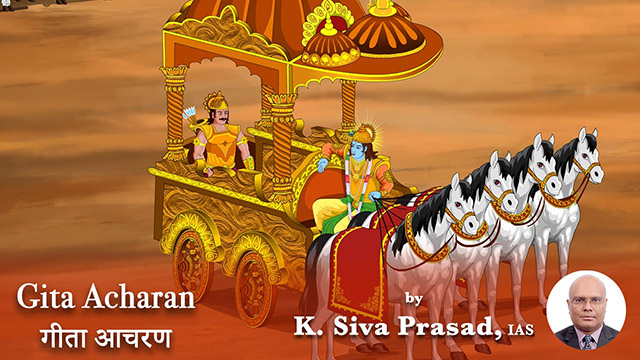
Balance is the key
Verse 2.38 captures the entire essence of the Gita. Krishna tells Arjuna that he would incur no sin when he fights (read as performing any karma )

Shun all Dharmas(natures) to unite with Paramatma (supersoul)
Krishna explains about swa-dharmam (2.31-2.37), Para-dharmam (other's nature) (3.35) and finally advises shunning all Dharmas (18.66) to unite with Paramatma .

In harmony with Swa-Dharmam(own nature)
Krishna explains Swa-dharmam (own nature) (2.31-2.37) and he tells Arjun that such an unsought battle (Kurukshetra)..

Rose Can never become a Lotus
Krishna explains about Swa-dharmam (own nature) (2.31-2.37) and advises Arjun that as a Kshatriya he should not hesitate to fight(2.31) as it is his Swa-dharmam ....

Destination arrives when ahankaar departs
Krishna says (2.29) some see 'this' (atma) as a marvel, some speak of 'this' as a marvel, others hear of 'this' as a marvel, and even then none know 'this' at all..

Soul replaces old bodies
Krishna says (2:19, 2:20) that Atma neither kills nor is killed and only the ignorant think otherwise. It is unborn, eternal, changeless and ancient.

Writing on the water, Sand and Stone.
Krishna says (2.39) that after elucidating about Sankhya (awareness) (2.11–2.38) he would now explain yoga (or Karma Yoga), the practice ...

Balance is bliss
At the very beginning of the Gita (2:14), Krishna says that the meeting of the indriyas (senses) with the external objects causes polarities of pleasure and pain.

Creativity can not be destroyed
Two types of wise men have guided humanity in its quest to understand the inner self.

Death does not kill us
Krishna tells Arjun, "There is no time, past, present or future, when you, I and these rulers on the battlefield are not present.

Creativity creates, not creator
Dwelling further on Sat (real/permanence) and Asat (unreal/impermanence), Krishna asks us to contemplate on 'that' which is indestructible and which pervades all.

Sat(real) and Asat(unreal)
Krishna says Sat (reality/permanence) never ceases to be and Asat (unreal/impermanence) has no existence.

Four types of devotees
Krishna says that there are four types of devotees.

Transcending Gunas
Krishna says that there is no kartha for any karma.

Equanimity
Samatva(equanimity) is a common thread that runs across the Gita.

Satva, Tamo and Rajo Gunas
Most of us believe that we are the cause of all our actions and masters of our destiny.

Being witness
If one word could describe the entire Gita it would be ' Drishta ' (a witness), which appears in many contexts.

Controlling mind
Arjuna compares the mind to the wind and wants to know as to how to control it, so that it maintains balance.

Pain follows pleasure
Transcending polarity/duality (Dwandwa-atheeth) , is another master key in the Gita. Krishna advises Arjun repeatedly in different contexts, to attain this state.

Krishna in Corona
The Gita contains many master keys which have the capacity to open up many doors and bypass hurdles we face in the path of self realisation.

Identify friend and enemy
In the Gita, Lord Krishna says you yourself are your own friend and you yourself are your own foe.

Manifested and unmanifested
A small change in the trim tab attached to the rudder changes the course of a large ship.

Being Nimitta Matra
The Gita was born in the battlefield and the current COVID-19 days are similar to the Kurukshetra battle.

Rule of law
The Gita is about maintaining harmony in the inner world and the law is about maintaining order in the outer world.

Gyana, Karma and Bhakti Yoga
Gita appears different to different people based on their orientation.

Mind games
Gita lays emphasis on our senses as they are the gateways between our inner and outer world.

Its here and now
The Gita is about what we are. It is like being truthful apart from knowing the truth and that happens when we are centered (space) in the present moment (time)

Contradictions in Life
Just as it is said, "All roads lead to Rome", all paths given in the Gita lead us to the Inner Self. Some of the paths appear to be in contrast with each other.
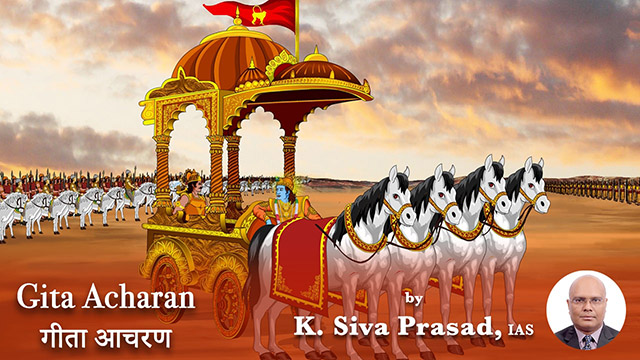
Start with Ahankaar
Bhagavad Gita is a 700 verse conversation between Lord Krishna and Warrior Arjun in the battle field of Kurukshetra.
